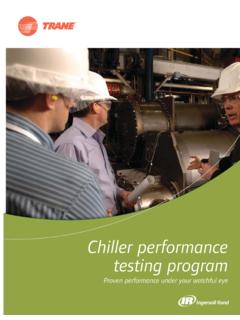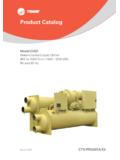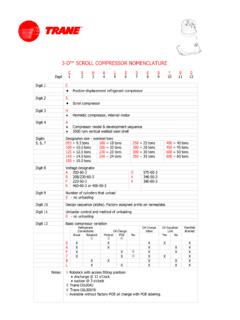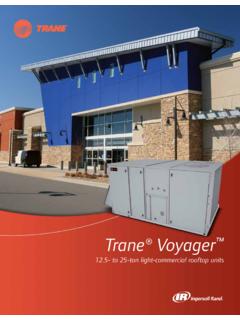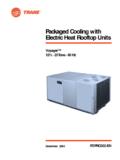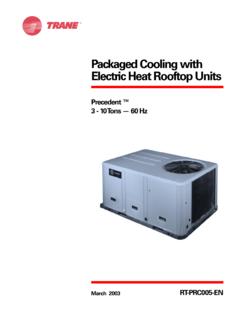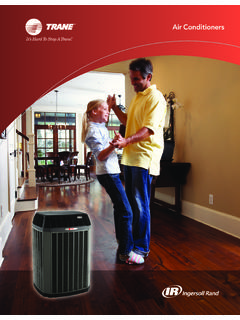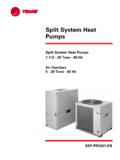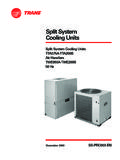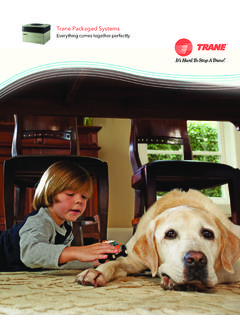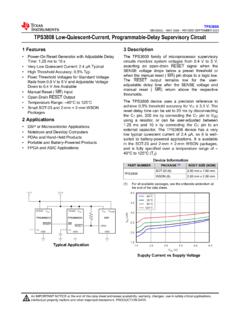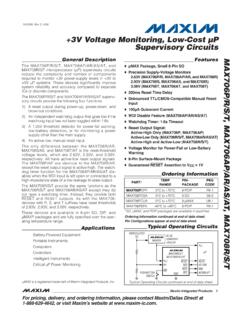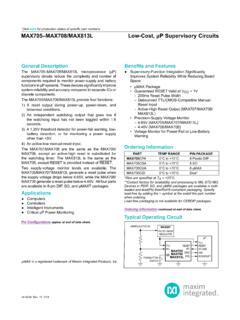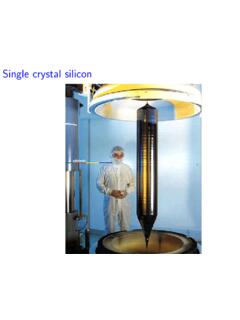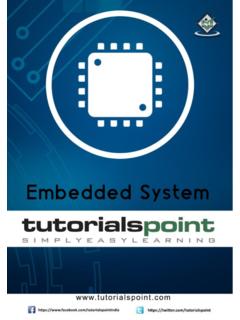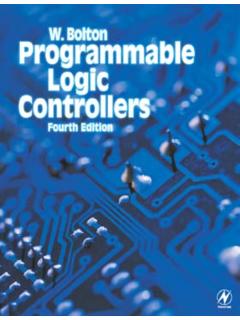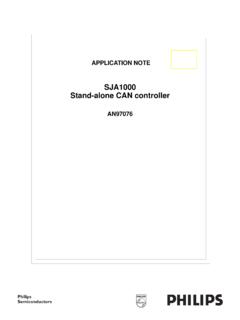Transcription of Diagnostic Troubleshooting Repair - Trane
1 August 2005 RLC-SVD03A-EN American Standard Inc. 2005 Model RTAA 70-125 TonRTWA 70-125 TonRTUA 70-125 TonDiagnosticTroubleshootingRepairSeries R 70-125 Ton Air-Cooled and Water-Cooled Rotary Liquid Chillers2 RLC-SVD03A-EN Important - Read This First!This manual is intended for experienced service personnel familiar with the proper use of electrical Diagnostic instruments and all personal safety procedures when working on live electrical Manual is not intended for individuals who have not been properly trained in handling live electrical Concerns!Scientific research has shown that certain man-made chemicals can affect the earth s naturally occurring stratospheric ozone layer when released to the atmosphere. In particular, several of the identified chemicals that may affect the ozone layer are refrigerants that contain Chlorine, Fluorine and Carbon (CFCs) and those containing Hydrogen, Chlorine, Fluorine and Carbon (HCFCs). Not all refrigerants containing these compounds have the same potential impact to the environment.
2 Trane advocates the responsible handling of all refrigerants including industry replacements for CFCs such as and HCFCs and HFCs. Responsible Refrigerant Practices! Trane believes that responsible refrigerant practices are important to the environment, our customers, and the air conditioning industry. All technicians who handle refrigerants must be certified. The Federal Clean Air Act (Section 608) sets forth the requirements for handling, reclaiming, recovering and recycling of certain refrigerants and the equipment that is used in these service procedures. In addition, some states or municipalities may have additional requirements that must also be adhered to for responsible management of refrigerants. Know the applicable laws and follow them. WARNINGC ontains Refrigerant!System contains oil and refrigerant under high pressure. Recover refrigerant to relieve pressure before opening the system. See unit nameplate for refrigerant type. Do not use non-approved refrigerants, refrigerant substitutes, or refrigerant to follow proper procedures or the use of non-approved refrigerants, refrigerant substitutes, or refrigerant additives could result in death or serious injury or equipment : Warnings and Cautions appear at appropriate sections through-out this literature.
3 Read these carefully. WARNING: Indicates a potentially hazardous situation which, if not avoided, could result in death or serious injury. CAUTION: Indicates a potentially hazardous situation which, if not avoided, may result in minor or moderate injury. It may also be used to alert against unsafe : Indicates a situation that may result in equipment or property-damage only Information .. 4 Service Philosophy .. 4 System Description .. 5 System Level Components .. 5 Interprocessor Communications .. 8 IPC Diagnostics .. 8 Troubleshooting Modules Using IPC Diagnostics .. 9 Troubleshooting Procedure .. 12 Temperature Sensor Checkout .. 15 Temperature Sensor Checkout Procedure .. 15 Compressor Operation .. 19 Restart Inhibit Timer .. 19 Compressor Start/Stop .. 20 Variable Speed Inverter/Condenser Fan Control .. 21 Outdoor Air Temperature and Fan Control .. 22 VSF Inverter Fault .. 22 Current Transformer .. 23CT and MCSP Compressor Current Input Checkout Procedure.
4 24 Under-Over Voltage Transformer .. 32 Under-Over Voltage Transformer Checkout .. 32 Compressor Capacity .. 34 Checkout Procedure for MCSP Load/Unload Outputs .. 35 Checkout Procedure for the Slide Valve and Load/Unload Solenoids .. 36 Checkout Procedure for MCSP Step Load Output .. 39 Checkout Procedure for Step Load Solenoid Valve and Piston .. 40 Module Power and Miscellaneous I/O .. 41 Power Supply .. 41 Clear Language Display (CLD) 1U6 Keypad Overview .. 42 Chiller Module (CPM) (1U1) .. 46 Options Module (CSR) (1U2) .. 50 Electronic Expansion Valve Module (EXV) (1U3) .. 58 Compressor Module (MCSP) (1U4 AND 1U5) .. 72 Interprocessor Communication Bridge Module (IPCB) (1U7) .. 78 LonTalk Communications Interface - Chillers Module(LCI-C) (1U8) .. 79 Variable Speed Fan System .. 80 Inverter Diagnostics .. 80 Troubleshooting Procedure .. 82 Other Service Features .. 85 Service Pumpdown .. 85 circuit Lockout .. 87 circuit Diagnostic Reset.
5 874 RLC-SVD03A-ENGeneral InformationThe Unit Control Modules (UCMs) described in this Troubleshooting guide provide a microprocessor based refrigeration control system, intended for use with Trane 70-125 ton helical rotor chillers. Six types of modules are used, and throughout this publication will be referred to by their abbreviations or their Line Wiring Drawing Designations, see Ta b l e PhilosophyWith the exception of the fuses, no other parts on or within the modules are serviceable. The intent of the Troubleshooting is to determine which module is potentially at fault and then to confirm a module problem. This is done either through voltage or resistance measurements at the suspected input or output terminals or by checking related wiring and external control devices (connectors, sensors, transformers, contactors etc.) in a process of elimi-nation. Once a problem has been traced to a module, the module can be easily replaced using only basic tools. In general, all dip switch settings of the replaced modules should be copied onto the replacement module's dip switches before applying control power.
6 CPM replacement is more involved as there are numerous configuration and set-up items that must be programmed at the Clear Language Display in order to insure proper unit is helpful to include with the return of a module, a brief explanation of the problem, sales office, job name, and a contact person for possible follow-up. The note can be slipped into the module enclosure. Early and timely processing of Field Returns allows for real measurements of our product quality and reliability, providing valuable information for product improvement and possible design 1 Unit Control Module DesignationsLine DrawingDesignationController NameChiller ModuleCSR1U3 Expansion Valve ModuleEXV1U4 & 1U5 Compressor ModuleMCSP A & B1U6 Clear Language DisplayCLD1U7 InterprocessorCommunications Bridge(Remote Display Buffer)IPCBRLC-SVD03A-EN5 General InformationSystem DescriptionThe CPM is the master module and coordinates operation of the entire system. One is used per chiller. The MCSP is a compressor protection module with one being used for each of the compressors in the chiller.
7 The EXV is the expansion valve controller module which controls two Electronic Expansion Valves. There is one valve on each of the two refrigeration CLD is a two line, 40 character alphanumeric interface to the system. It allows the operator to read operating and Diagnostic information, as well as change control parameters. The Interprocessor Communications Bridge (IPCB) provides an extension of the IPC link to the Remote Clear Language Display, while protecting the integrity of the IPC communications link between the local CSR is an optional communications module which allows for communica-tions between the chiller and a remote building automation system ( Tracer, Tracer Summit, Generic BAS).All modules in the system communicate with each other over a serial inter-processor communications bus (IPC) consisting of a twisted wire pair daisy chain link and RS485 type signal levels and drive capability. Multiple modules of the same type ( MCSPs) in an operating system are differentiated by address dip the modules operate from 115 VAC, 50 or 60Hz power and each have their own internal step-down transformer and power supply.
8 Each is individually fused with a replaceable fuse. The modules also are designed to segregate their high and low voltage terminals by placing the high voltage on the right side of the module and the low voltage on the left. When stacked, segre-gation is addition to the modules, there are a number of system level compo-nents that are closely associated with the modules. These components were specifically designed and/or characterized for operation with the modules. For this reason, the exact Trane part must be used in Level ComponentsDescriptionThe following is a list of all the components that may be found connected to the various , Under/Over voltageCurrent Transformer - CompressorEvap EntlLvg Water Temp Sensor PairSat Evap/Cprsr Suc Rfgt Temp. Sensor PairSat Cond RfgtIOil Temp Sensor Pair Outdoor Air Temperature Sensor Zone Temp SensorConnector (UCM mating connectors) Connector Keying Plug Electronic Expansion Valve 6 RLC-SVD03A-ENGeneral InformationHigh Pressure Cutout Switch Low Pressure Cutout Switch Variable Speed Fan Drive Motor Temperature Thermostats Slide Valve Load/Unload Solenoids Step Load Solenoid ValveChiller Module (CPM) IU1 The CPM module performs machine (chiller) level control and protection functions.
9 Only one CPM is present in the chiller control system. The CPM acts as the master controller to the other modules, running top level machine control algorithms, initiating and controlling all inter-module communication over the IPC, and providing parameters and operational requests ( loading and unloading, starting and stopping) to the other modules in the system via the IPC. The CPM also contains nonvolatile memory, which allows it to remember configuration and set-up values, setpoints, historical diagnostics etc. for an indefinite period of time following a power loss. Direct hard wired I/O associated with the CPM includes low voltage analog inputs, low voltage binary inputs, 115 VAC binary inputs and 115 VAC (rated) relay outputs. See Chiller Module (CPM) (1U1) on page 46 for further Module (MCSP) 1U4 and 1U5 The MCSP module employs the input and output circuits associated with a particular compressor and refrigeration circuit . Two MCSP modules are used in the UCM system, one for each compressor.
10 Included are low voltage analog and digital circuits, 115 VAC input, and 115 VAC output switching devices. The output switching devices associated with the compressor motor controlling function are contained in this module. The outputs of this module control one compressor motor stop/start contactor, one compressor motor transition contactor, one oil heater, three solenoid valves (compressor load, compressor unload, step loader), and up to four fan motor contactors or groups of contactors. Refer to the chiller's line wiring diagrams for details. Dip switches are provided for redundant programming of the compressor current overload gains, and for unique IPC address identification during operation. Inputs to this module include motor temperature thermostats, thermisters, and safety switches. See Compressor Module (MCSP) (1U4 AND 1U5) on page 72 for Valve Module (EXV) 1U3 The EXV module provides power and control to the stepper motor driving the electronic expansion valves of the chiller.
